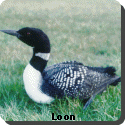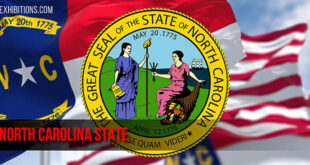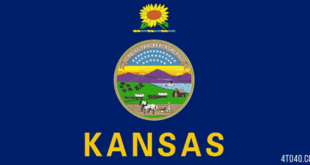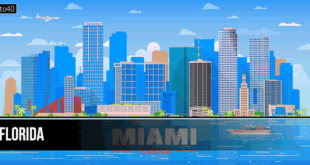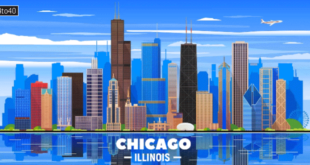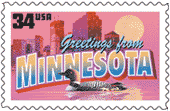 Minnesota, located close to the center of the North American continent, contains the northernmost point in the continental United States, the Northwest Angle. Much of the boundary of Minnesota is outlined by natural waterways. A large portion of the north and northeast is separated from Manitoba and Ontario by Lake of the Woods, Rainy River, Pigeon River, Lake Superior, and numerous other lakes that stretch in an almost unbroken chain. Lake Superior and the Saint Croix and Mississippi rivers mark most of its eastern boundary with Wisconsin; to the west, the Red River of the North and Big Stone and Traverse lakes separate Minnesota from the Dakotas. The state is bordered by Iowa to the south.
Minnesota, located close to the center of the North American continent, contains the northernmost point in the continental United States, the Northwest Angle. Much of the boundary of Minnesota is outlined by natural waterways. A large portion of the north and northeast is separated from Manitoba and Ontario by Lake of the Woods, Rainy River, Pigeon River, Lake Superior, and numerous other lakes that stretch in an almost unbroken chain. Lake Superior and the Saint Croix and Mississippi rivers mark most of its eastern boundary with Wisconsin; to the west, the Red River of the North and Big Stone and Traverse lakes separate Minnesota from the Dakotas. The state is bordered by Iowa to the south.
It has been said that Minnesota’s way of life seems permanently positioned in the middle of the American dream. This dream drew many immigrants to the state, bending people to the plow with the promise of a life of plenty, peace, and dignity in return for their honest labor. Minnesota received its name from the largest river that lies wholly within its boundaries; the Sioux called the river the Minnesota, meaning “clouded water,” because of the light-colored clay it carried in suspension.
Land & Resources
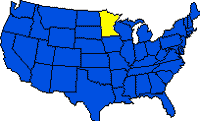 More than two-thirds of Minnesota is nearly flat or gently rolling, with a mean elevation of 366 m (1,200 ft) above sea level. This central region is surrounded by areas of dissimilar topography. In the northeast, both the lowest and highest points in Minnesota are found in Arrowhead Country, named for its triangular shape. This area is structurally part of the CANADIAN SHIELD, underlaid with granite, gneiss, and schist. The flat prairies of the northwest and west, now the eastern plain of the RED RIVER OF THE NORTH, were once part of the ancient Lake Agassiz basin and overlie limestone and shale. To the southeast, the Driftless Area is marked by incised streams and cross-cutting valleys. The state’s eastern boundaries exhibit remnants of ancient volcanic activity.
More than two-thirds of Minnesota is nearly flat or gently rolling, with a mean elevation of 366 m (1,200 ft) above sea level. This central region is surrounded by areas of dissimilar topography. In the northeast, both the lowest and highest points in Minnesota are found in Arrowhead Country, named for its triangular shape. This area is structurally part of the CANADIAN SHIELD, underlaid with granite, gneiss, and schist. The flat prairies of the northwest and west, now the eastern plain of the RED RIVER OF THE NORTH, were once part of the ancient Lake Agassiz basin and overlie limestone and shale. To the southeast, the Driftless Area is marked by incised streams and cross-cutting valleys. The state’s eastern boundaries exhibit remnants of ancient volcanic activity.
During the Pleistocene Epoch, all but the southeastern corner of the state was subjected to the action of four major glaciers. The last advance is largely responsible for the present physical landscape. Central Minnesota has the state’s most complete pattern of moraines and accompanying outwash sediments.
Climate
A humid continental climate dominates the state, but considerable variation occurs within its borders. Minnesota is susceptible to outbreaks of cold polar air from the north as well as occasional warm moist air from the Gulf of Mexico. The January mean temperature ranges from -17 deg C (1 deg F) in the northwest to -9 deg C (16 deg F) in the southeast. July mean temperatures vary between 15 deg C (59 deg F) in the northeast and 23 deg C (74 deg F) in the southwest. Precipitation amounts of 813 mm (32 in) in the extreme southeast decrease to 483 mm (19 in) in the northwestern corner. Although snow and rain are equally common in Minnesota, most of the precipitation falls as rain, averaging 635 mm (25 in) yearly. The average annual snowfall of 1,143 mm (45 in) would equal 114 mm (4.5 in) of liquid.
Tourism
Lured by lakes, rivers, and forests, tourists spend more than $4 billion annually in Minnesota. Canoeing and boating are popular summer activities. Trails for hiking and, in winter, for snowmobiling and cross-country skiing wind through the many state parks and recreation areas. National parklands include Voyageurs National Park, the only water-based national park; Grand Portage National Monument on Lake Superior; and Pipestone National Monument in southwestern Minnesota. Other attractions are the Boundary Waters canoe area, statues of Paul Bunyan and Babe at Brainerd and Bemidji, and the St. Paul Winter Carnival. Minnesota also supports professional baseball, football, basketball and hockey teams.
History
Whether a French or Viking explorer first entered the Minnesota area is debatable. The KENSINGTON RUNE STONE, discovered near Alexandria in 1898, purports to record the visit of VIKINGS in 1362. Continuous recorded history, however, indicates that those who opened the territory included the Frenchmen Samuel de CHAMPLAIN; Daniel Greysolon, Sieur DULUTH; Louis HENNEPIN; Robert Cavelier, Sieur de LA SALLE; Jean NICOLET; Pierre Esprit RADISSON; and Medard Chouart, Sieur des Groseilliers.
Through their efforts, the great northern wilderness was claimed as part of the French Empire in North America. When France yielded its North American territories to Great Britain by the 1763 Treaty of Paris, the Union Jack replaced the French tricolor in the territory east of the Mississippi. After the American Revolution the area became a part of the United States. The territory west of the Mississippi, previously under the sovereignty of Spain, came to the United States as part of the LOUISIANA PURCHASE.
Settlement of the territory began with the building in 1819 of Fort Anthony, renamed Fort Snelling in 1825. The fort, located at the junction of the Mississippi and Minnesota rivers, served as a military center and base for western exploration. The first white people to make permanent homes in Minnesota were farmers who lived in and around the fort. Many were French-Canadian voyageurs, carried west by their work in the fur trade. A few men and women had come from the east as traders, missionaries, or soldiers. Also present were a handful of Europeans–mostly Swiss and Scottish–who had fled the dangers and hardships of life in the Selkirk Colony RED RIVER SETTLEMENT to the north. When lands of the Sioux and Chippewa were placed on sale, many families from the eastern United States settled, along with French Canadians. Germans, Swedes, and Norwegians arrived following the establishment of a land office in Saint Croix Falls in 1848.
On Mar. 3, 1849, the Territory of Minnesota was created. Its northern, eastern, and southern boundaries were the same as those of today, but its western limits extended to the Missouri and White Earth rivers–encompassing most of present-day North Dakota. During the 1850s, Indians relinquished their claims to areas within the territory, and in 1858, Minnesota was admitted to the Union.
The state experienced no fighting within its borders during the Civil War, but Minnesota did contribute soldiers to the Union effort. During 1862 a Sioux uprising in the state was brought about by a lack of food and money for the reservation inhabitants. (The funds and supplies had been diverted to the war effort.) A confrontation took place between four Sioux and some white settlers that resulted in the death of five whites. Apprehension among the Sioux brought about their arming for war. More than 400 settlers were killed by the Sioux within a few days. After the Sioux were captured, 306 were sentenced to death and 18 to prison terms. President Lincoln intervened and commuted the death sentences of all but 39 prisoners, thus incurring the resentment of the Minnesota settlers.
The state’s economy was centered on wheat farming, milling, and lumbering. Beginning in the 1880s, however, the exploitation of iron ore became significant. In 1884 the first shipment of ore was made from the Vermilion Range, followed in 1892 by extraction from the Mesabi Range. Steel production at the U.S. Steel Corporation plant in Duluth began in 1915.
Twentieth-century agriculture in Minnesota has moved from a concentration on wheat growing to dairying, with stress placed on the manufacture of butter and cheese. Flour milling has been in decline because shipping grain is easier than transporting flour.
The opening of the ST. LAWRENCE SEAWAY in 1959 made Duluth a world port, enabling the state’s products to be shipped easily. Greater industrial development, however, has created environmental concerns. In the early 1980s, Minnesota was hurt economically by a widespread slump in farm prices but was less affected by the national recession of the early 1990s. The 1990 census revealed large increases in Minnesota’s black and Indian populations, the latter apparently resulting from greater numbers claiming their Indian identity.
Land
- Area: 225,182 sq km (86,943 sq mi); rank: 12th.
- Capital: St. Paul (1990 pop., 272,235).
- Largest city: Minneapolis (1990 pop., 368,383).
- Counties: 87.
- Elevations: highest–701 m (2,301 ft), at Eagle Mountain; lowest–184 m (602 ft), at Lake Superior.
 Kids Portal For Parents India Kids Network
Kids Portal For Parents India Kids Network

